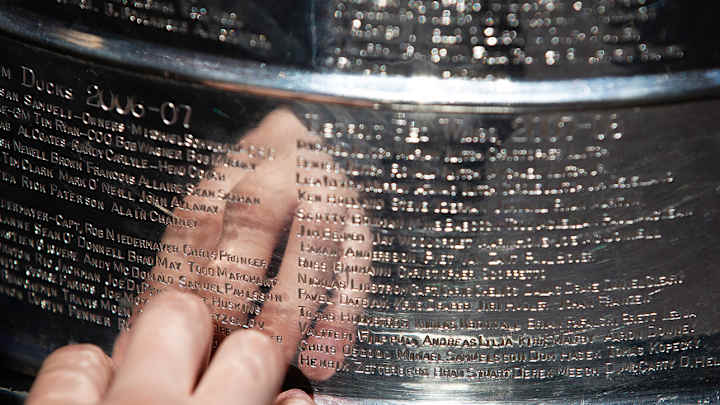Capitals Etched in Stanley Cup History ... For Now

The changing of the guard occurred during the last week of September, when Louise St. Jacques loosened four screws on the inside of the Stanley Cup and separated the punch bowl and neck from its sterling barrel. Next the Montreal silversmith removed the trophy's five circular bands, taking care to set the topmost one aside. It was the oldest of the group, stamped with the names of legends: Bobby Hull, Maurice Richard, Ted Lindsay, Gordie Howe, Jean Beliveau … Soon it would be flattened, cleaved in half, and shipped away for permanent display.
Unceremonious? Not quite. The retired band will be entombed in the Esso Great Hall, a supposedly haunted old bank building adorned with florid architecture and a stained dome ceiling. There it will be gazed upon by fans making pilgrimages to Toronto's Hockey Hall of Fame, some of whom will wistfully recall watching those grayscale greats win championships between 1953-65, the decade-plus dominated by Toe Blake's Canadiens and Punch Imlach's Maple Leafs. Others, still, might consider the regenerative cycle that repeats on Lord Stanley's chalice every 13 years, which again whirred into motion as St. Jacques grabbed her screwdriver.
"It's a good day," says goalie Glenn Hall, who backstopped Chicago to the ‘61 title, "and it's a sad day."
2018–19 NHL Predictions: Stanley Cup Winner, Hart Trophy, Art Ross and More
More than anything, it is necessary. In 1992 a group of Hall of Fame officials and NHL executives performed some quick calculations and determined that the Stanley Cup was growing at an unsustainable rate. Unwilling to return to the trophy to its days of resembling a pachyderm's leg—the only kind of elephant welcome in a hockey locker room—the group decided to simply replace the oldest band when all five were filled up.
This is where St. Jacques comes in. She is the operator of Boffey Promotions, an engraving business located in the old Montreal district, around the corner from Notre-Dame Basilica and above a sushi restaurant. She is also the fourth official engraver of the Stanley Cup, an annual process that St. Jacques explained in a brief email to SI. Most of her time is spent holding a hammer and metal shank with a raised letter at the end, punching each name into the surface. Between planning and executing, she typically finishes in five days.
And so, after removing the 1954-65 band and its 340 total names, St. Jacques set to work on stamping the fresh one. The 2017-18 Washington Capitals got their first look at the finished product during Monday's ring ceremony, stooping low to scan the silver and snap pictures. (As the newbie on the block, their band starts on the bottom.) One of those players was defenseman Brooks Orpik, who remembers learning about the outgoing band when the Stanley Cup visited his house in Cohasset, Mass., this summer.
"You almost feel guilty, getting your name on it and having those guys come off," Orpik says. "But the small amount of guilt you have goes away pretty quickly."
Next Man Up: Nathan MacKinnon Is Ready to Join the Game's Greats
Twelve future champions will join Washington (assuming nothing happens like with the 1964-65 Canadiens, who inexplicably consume twice the space), meaning that the next removal is due for 2031. The likes of Bobby Orr and the Broad Street Bullies will come down for flattening then, joining 1927-40, 1940-53, and 1953-65 at the Hall of Fame. Since the Capitals were first on their band, they will stay affixed onto the barrel for 65 years, a staggering thought for those involved. "I told my wife, I'm 38 now, so I'll be on there until I'm dead," Orpik says. "I don't know if she liked me saying that, but that was me being honest of the situation."
For now, though, the Capitals are focused on their short-term future. When the Bruins visit Wednesday night, a banner will raise in Washington, a new season will start, and the next space on the Stanley Cup will be up for grabs. "It's empty there beside us," center Nicklas Backstrom says. "Might as well go win again."
